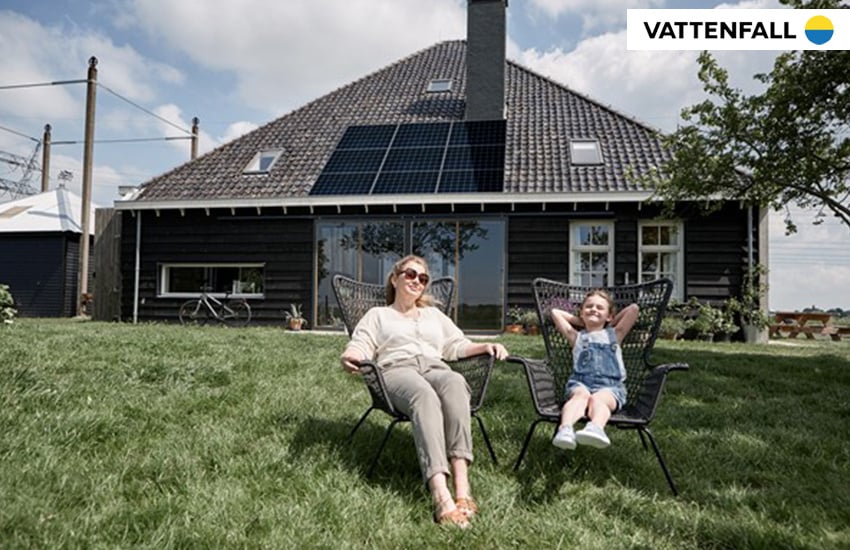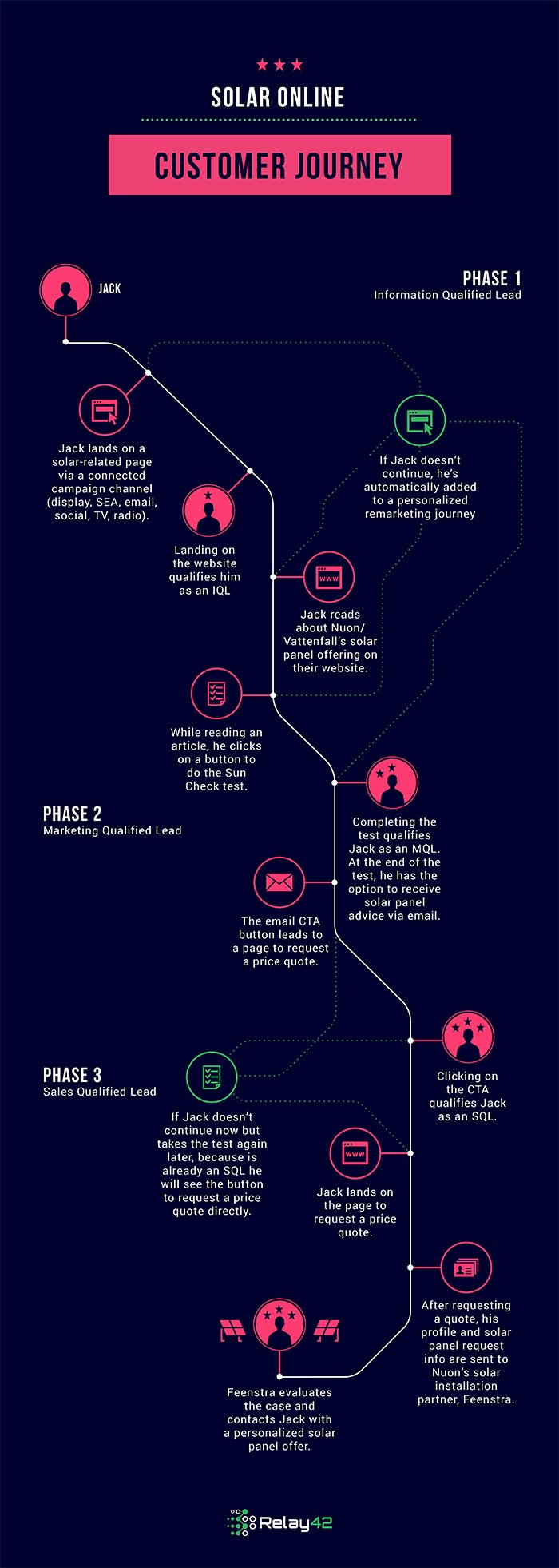Customer Data Platform Insights
Vattenfall Digital Marketers Improve the Customer Journey with Relay42

The Utilities CDP Insights from Vattenfall
Exciting things are happening in the Marketing department over at Vattenfall. In this article, we’re catching up with Database Marketer Guido Noodelijk and Senior Digital Marketing Specialist Giovanni Zebeda to talk about the digital concept behind their latest national campaign.
Re-branding sparks New Energy Solutions team
(Formerly) Nuon, one of the largest energy suppliers in the Netherlands, is undergoing a merger and rebranding with their mother company, Vattenfall. Vattenfall is on a mission to be fossil-free in a generation, which means that the first task on their list has been to transform Vattenfall into a green energy provider.
A generation is 20-30 years, making the use of solar energy today absolutely crucial. With the first phase of the merger working to introduce Nuon audience to the Vattenfall brand, and the second and current phase for Vattenfall to go green, what better way to do it than with a solar panel campaign?
The dream interdisciplinary team
Green energy isn’t the only new thing happening at Vattenfall. Guido and Gio are both part of the interdisciplinary New Energy Solutions Team, which is focused on realizing Vattenfall’s vision to stimulate the use of green energy through innovative technologies. Their team was given the task of managing the digital side of the national solar panel campaign, including providing all campaign leads to their sister company, who follows up via telephone.
Guido is primarily focused on email marketing, while Gio focuses on online channels, acting as a lynchpin between the New Energy Solutions team and Data, Traffic and UX. His role is to ensure the New Energy Solutions team delivers high-quality leads from the online channels they’re using in the solar panel journey.
Together, Guido and Gio ensure that online, database, and later offline marketing operations work in the most optimal, synchronous way possible. According to the pair, this new style of multidisciplinary team is definitely shaking things up. Besides ensuring that the right people with the right expertise have to opportunity to collaborate and innovate, it’s also making room for a whole new level of data-driven marketing.
Data-driven marketing
More than anything, data-driven marketing is about being agile and goal-oriented. Vattenfall’s New Energy Solutions team is on a mission to reach their solar panel sales targets as efficiently as possible, and the way Guido sees it, “It all goes back to reaching the right person at the right time on the right channel.”
In order to get there, they are working hard to connect online and offline channels so they can hone their omnichannel approach and create a 360-degree view of the customer that will enable them to further personalize, optimize and fine-tune their customer journeys.
Vattenfall’s New Energy Solutions team takes on the lead qualifying process
Vattenfall’s solar energy campaign was designed to lead interested customers and prospects through an online funnel to the Do the Sun Check test. Thanks to a highly successful offline advertising campaign, the company has had no shortage of interested leads. On the contrary, the New Energy Solutions team has been struggling to properly handle the huge surge of incoming leads.
Their flow was set up in such a way that if a prospect qualified as a lead by scoring high on the Sun Check test, they were shown a button to request a price quote. Once they requested a quote, their information was sent to a sister company who would look into the details of the lead’s test, put together a quote, and then contact the prospect by telephone to discuss their options.
This highly personalized approach for hot leads is a time-consuming process for Vattenfall’s sister company, and eventually, they couldn’t keep up with the high demand for price quotes.
“And that’s how we got started with this whole story,” says Gio. “The problem really began as a capacity issue. Leads were delivered and couldn't be picked up until two weeks later, or sometimes not at all, and customers were putting comments on Facebook like, ‘Hey, I requested a quote and I haven't heard anything.’”
On top of that, 90% of the leads being delivered weren’t qualifying. “And that means you might be disappointing clients or giving them a negative experience,” says Gio. “We realized the only thing we could do to improve the situation was to improve the quality of the leads, so we got to work finding a solution.”
“More than anything, data-driven marketing is about being agile and goal-oriented. Nuon/Vattenfall’s New Energy Solutions team is on a mission to reach their solar panel sales targets as efficiently as possible, and it all goes back to reaching the right person at the right time on the right channel.”

Guido Noodelijk
Database Marketer | Nuon Vattenfall
Centralizing the customer service touchpoints
Randstad wants to empower their customers so that they can find the right job for them in a way that's fast and efficient. To improve their digital customer service, the online marketing team decided to centralize their communication via the website, by driving the customer questions to their chatbot service, Ella.
In the past, the customer service channels included dozens of phone numbers and hundreds of email addresses. Since live chat via the chatbot was already a customer service touchpoint, the marketing team saw it as the ideal solution that could serve as a central tool for helping the candidates on their journey.
With the chatbot, the marketing team aimed to encourage candidates to look for the answers to their questions on the Randstad website themselves, and only when a question was too complex or too specific, they would be sent to a customer support agent via the live chat.
The customer support agent would then be able to see the whole history of the chat so that they could understand exactly what the candidate is looking for and help them quickly. By providing the history of the chat, Randstad was able to significantly reduce the average time for a conversation — from an average of 8 minutes down to an average of 5 minutes per conversation.

In the infographic on the left, you can see one of the possible customer journeys.
A/B Testing
The New Energy Solutions team started experimenting on their own by setting up the website so that only half of the visitors would see the button to request a price quote, and the other half would see an “email me advice” button. It delivered fewer leads, which was good, but because it was set up to randomly who would/wouldn’t see the option to request a quote directly, Vattenfall was potentially losing highly qualified leads.
The New Energy Solutions team liked the general idea, but they wanted to be able to do it based on user behavior, such as who had engaged with relevant solar panel content on their website.
“This was already happening last year,” says Guido, “but at that point, I wasn't working with Relay42. I didn't even know what it was. And that's actually a really good example of how the link between the marketing and online teams is way too minimal. I didn't even know what Relay did a year ago.”
Improving lead generation with the Relay42 platform
Vattenfall had already been working with the Relay42 platform since 2012, but in such a large organization, not everyone knows about every tool being used. Once Guido and Gio began looking for a way to solve their lead scoring problem, they found about the perfect tool for the job — one that they already had.
They got in touch and started working with Relay42 consultant Dick Heerkens. From there, Gio, Guido and Dick worked together in weekly meetings to come up with a new lead scoring model and process for qualifying solar panel leads.
“Gio, Dick and I did all of this together with the three of us. It was really nice that Dick was there, with so much expertise in Relay42, so we didn't have to lose any time on that.”
The big experiment: a new lead scoring model
“We have all kinds of online channels, and then the website,” explains Gio, “and Relay42 is the layer on top of it all that allows us to track everything, do lead scoring, qualify leads, and perform trigger-based actions based on behavior. So Relay42 has a really wide reach over our marketing organization.”
The first step to improving the lead process with the Relay42 platform was to define a new lead scoring model. The team started by dividing the customer journey into three different phases and then assigning a certain number of points to different possible interactions in each phase.
After mapping out the customer journey, Lesley Declercq, Technical Consultant at Relay42, got involved to create a brand new lead scoring model in the Relay42 platform for Vattenfall.
"The road to shaping the model was quite complex,” says Dick, “but working together in a multidisciplinary team meant we could act quickly and develop the model in a relatively short period of time."
Then they built a few shortcuts into the process, such as if a person engages with specific bottom-of-funnel content, they get so many points that they qualify directly. By working with points, they are able to manipulate lead scoring in such a way that prospects with enough interest always fall into the last phase — and those who aren’t interested enough or not qualified, don’t.
Finally, they set up a dynamic results page for the Sun Check so that only qualified leads would see the button to request a price quote, and everyone else would see the button to request more information via email.
Next steps
“But does the current scoring make sense with those phases?” Guido ponders. “We don't know yet, but we'll find out soon with this experiment. Do people land on a page once or ten times? Should you only assign points for unique visits or not? Those are all questions we have that should be answered with this campaign.
Once the results are in, it will be the team’s task to continue their data-driven marketing efforts by adjusting their KPIs to fit with the new model, and then test and optimize again. They already believe that visitors who have more engagements convert more easily; the question is whether or not the data coming from this campaign will prove that.
“Right now, we actually don't know what someone's journey looks like,” Gio explains. “If someone is looking for a solution online, for example, does it take a day or a month? We hope to get some insights on that.
“If this gets more traction within the organization, then a lot more teams are going to start thinking about how they can apply it,” says Guido. So in addition to improving their customer journey, perhaps the New Energy Solutions team is also improving their colleagues’ journeys as well.
Driving Marketing Growth Value for Inspiring Brands

+115% Conversion Rate Uplift on Brand Search
Levi's Strauss & Co.

+25% In revenue via email marketing
KLM Royal Dutch Airlines
.png?width=750&height=500&name=Untitled%20design%20(28).png)
+272.75% Increase in the number of vacancy alerts
Randstad
.png?width=750&height=500&name=Untitled%20design%20(25).png)
+86% Increase in leads
Vattenfall
.png?width=750&height=500&name=Untitled%20design%20(27).png)
+90% Increase in requests for information
Mazda Netherlands
See Relay42 in Action
Experience a first-hand tour of the Relay42 Customer Data Platform with one of our consultants


